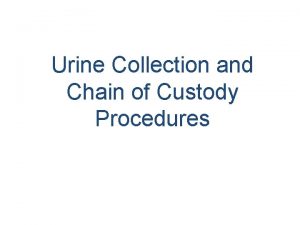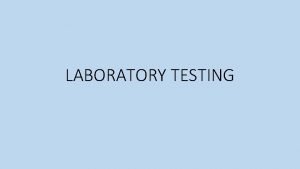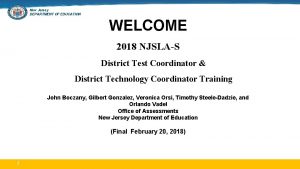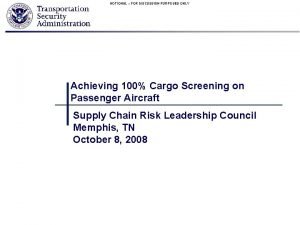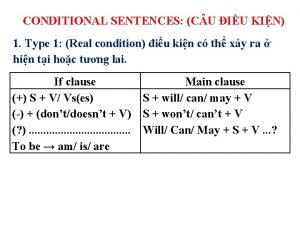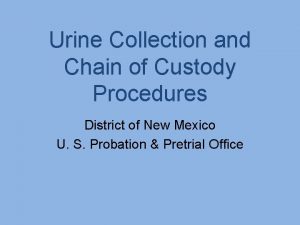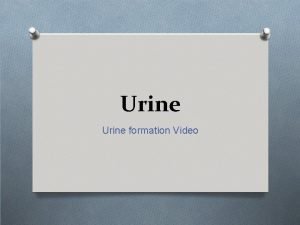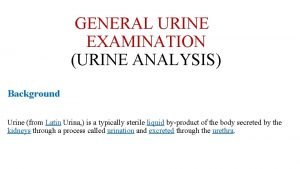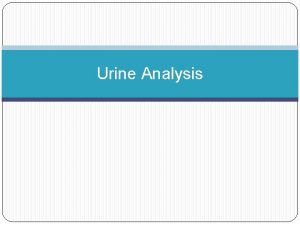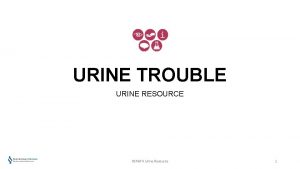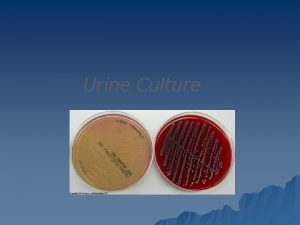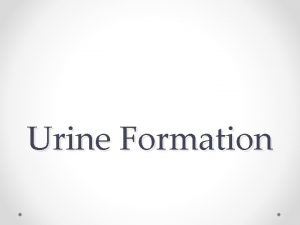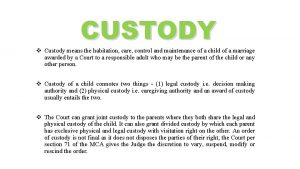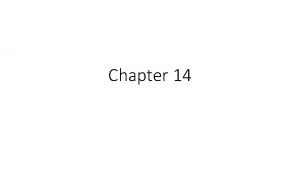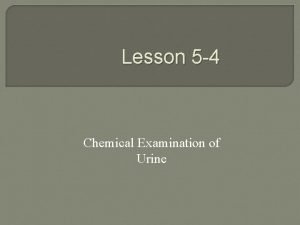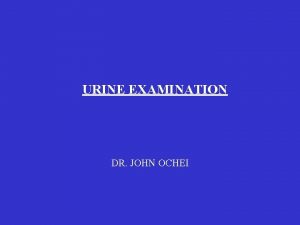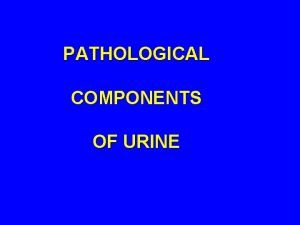Urine Collection and Chain of Custody Procedures Never

























- Slides: 25

Urine Collection and Chain of Custody Procedures

§ Never underestimate what an addict will do to conceal drug use or try to “beat” the drug test. § Although the Statement of Work establishes guidelines for unobserved urine collections, this method is highly discouraged.

Urine Collection- Step 1 § The defendant should be escorted from the waiting area to the collection area by the collector. § Be cognizant of body language and potential efforts to conceal a “cheating” device. § The collector and the defendant are the only people present in the collection area at this time. Multiple collections should not occur at the same time.

Urine Collection – Step 2 § The collector shall obtain supplies from a secured area in view of the defendant. § Chain of Custody (COC) form § Specimen ID labels § UA kit (contains cup, tamper seal, tamper evident bag) § Gloves (not supplied by USPO)

Urine Collection – Step 3 § The collector fills out the top portion of the COC form (defendant’s legal court name, date of birth, PACTS number, supervising officer, collection date/time, and medications). § Verify information on pre-printed forms.

Urine Collection – Step 4 § The defendant signs a specimen ID label. § The defendant affixes the signed specimen ID label to the bottle, and affixes the matching specimen ID label to the COC form. § Females can affix to bottle after giving sample. § Defendant initials and dates the tamper seal.

Urine Collection- Step 5 § The collector maintains control of all supplies and escorts the defendant into the restroom.

Urine Collection- Step 6 § Ask the defendant to remove any bulky (concealing) clothing, and to roll up sleeves so that wrists/forearms are in clear view. § It may be necessary to have defendant adjust clothing in order to adequately determine that a device is not being concealed on his/her body.

Urine Collection- Step 7 § The defendant will rinse hands with cold water (no soap) and dry them thoroughly. § Purpose of rinse is to eliminate any agent the defendant may use to contaminate his urine.

Urine Collection- Step 8 § The collector hands the labeled bottle to the defendant and positions himself in a manner to directly observe urine leave the body and enter the specimen bottle. § Ask defendant to fill bottle to the top.

Step 8 - continued § MUST collect at least 10 ml of urine. § 30 ml is ideal § The lab cannot test if less than 10 ml of urine is received; therefore, DO NOT send in a sample containing less than 10 ml. It will be a “no-test” -- and your agency is not paid for when specimens are not tested.

Urine Collection- Female § Because it may be impossible to see urine leave the female body and enter the cup, request a mid-stream collection. § Ask the female defendant to begin the flow of urine into the toilet, stop the flow, then resume the flow into the collection cup. § Defendant’s other hand should be in clear view, away from the collection cup.

Urine Collection- Step 9 § After urine is collected, the defendant places the cap tightly on the bottle to prevent leakage. (Close lid and snap tab in place). § The defendant turns the bottle upside down over the sink to check for leakage.

Urine Collection- Step 10 § At the collection area, the defendant places the tamper-evident seal over the top of the bottle with both sides of the seal securing the bottle top and adhering to the sides of the bottle. At least one end of the seal must be placed over the specimen ID label.

Urine Collection-Step 11 § The defendant places the UA specimen into the tamper evident bag, along with an absorbent sheet.

Urine Collection- Step 12 § The defendant shall read, sign, and date the COC form under offender/defendant certification. § The collector shall complete the notes section of COC form, REVIEW the form for completeness, and then read, sign and date under collector certification.

Urine Collection – Step 13 § Before placing the COC form into the specimen bag, the collector has the opportunity to do a final review and verify that – § 1) specimen ID numbers on the COC form and specimen bottle match.

Urine Collection – Step 13 (Continued) § 2) specimen bottle is TIGHTLY sealed. § 3) specimen bottle is affixed with – § A) defendant-signed specimen ID label. § B) defendant-initialed tamper-evident seal that is placed OVER the specimen ID label. § C) security seal is intact and adhering to both sides of the bottle.

Urine Collection-Step 14 § The collector folds the form and places it into the document pocket of the tamper-evident bag. § The collector, in the presence of the defendant, removes the adhesive strip and folds the top of the bag over the front pocket guidelines.

DILUTE URINE § Dilute urine can be an indication that a defendant is attempting to “flush” his/her system with excess fluid to avoid drug detection. § Products sold to “beat drug tests” commonly use flushing as the method to avoid detection. § It is important to note on the COC form if urine appears dilute.

Stalling & Subsequent Attempts § If the defendant is unable to provide a specimen, the collector will complete the appropriate section of the COC form noting the stall and fax it to the supervising officer. § The unused bottle and COC form should be destroyed.

“NO TESTS” § TAMPER SEALS 1) broken 2) no initials/date 3) none on bottle 4) not overlapping both sides of bottle § SIGNATURES 1) defendant and/or collector missing on COC form 2) defendant missing on specimen ID label on bottle

“NO TESTS” Continued § SPECIMEN ID LABELS 1) none on bottle and/or not signed 2) none on COC form 3) numbers on bottle and COC do not match § URINE VOLUME 1) insufficient 2) complete leakage

“NO TESTS” Continued § SPECIMEN AND COC FORM – 1) not received in same bag 2) no COC received 3) no specimen received § NO MATCH – 1) specimen ID numbers on COC form/bottle 2) defendant initials on tamper seal do not match defendant name 3) name/Pacts # on COC form does not match defendant signature on COC form 4) name/Pacts # on COC form does not match defendant signature on bottle

Correctable errors (detected in presence of defendant) § Broken tamper seals – ok to place a second seal over the first – be sure top seal is initialed § Specimen ID labels – ok to place a second label over the first, on the bottle and/or COC form – be sure top label on bottle is signed. Specimen ID numbers on bottle and COC must match.
 Urine chain of custody form
Urine chain of custody form Chain of custody procedures
Chain of custody procedures Chain of custody procedures
Chain of custody procedures Who established the first workable crime laboratory?
Who established the first workable crime laboratory? Njsla chain of custody form
Njsla chain of custody form Njsla-s
Njsla-s Chain of custody
Chain of custody Dari hasil tes urine ternyata urine
Dari hasil tes urine ternyata urine Care and custody rostering
Care and custody rostering Direct custody
Direct custody Collection methods and procedures
Collection methods and procedures Food chain sequence
Food chain sequence Nurses responsibility in collection of urine specimen
Nurses responsibility in collection of urine specimen Joint legal custody
Joint legal custody The iac must ensure custody of air cargo using what methods
The iac must ensure custody of air cargo using what methods Camille grammer on frasier
Camille grammer on frasier Data collection procedure
Data collection procedure Your love never fails never gives up on me
Your love never fails never gives up on me We are never weary of the grand old song
We are never weary of the grand old song Because you speak english unnaturally
Because you speak english unnaturally He never polishes his shoes so he never looks smart
He never polishes his shoes so he never looks smart He never fails meaning
He never fails meaning What can run but never walks has a mouth
What can run but never walks has a mouth Landsat collection 1 vs collection 2
Landsat collection 1 vs collection 2 Documents against payment
Documents against payment What is logistics management
What is logistics management
